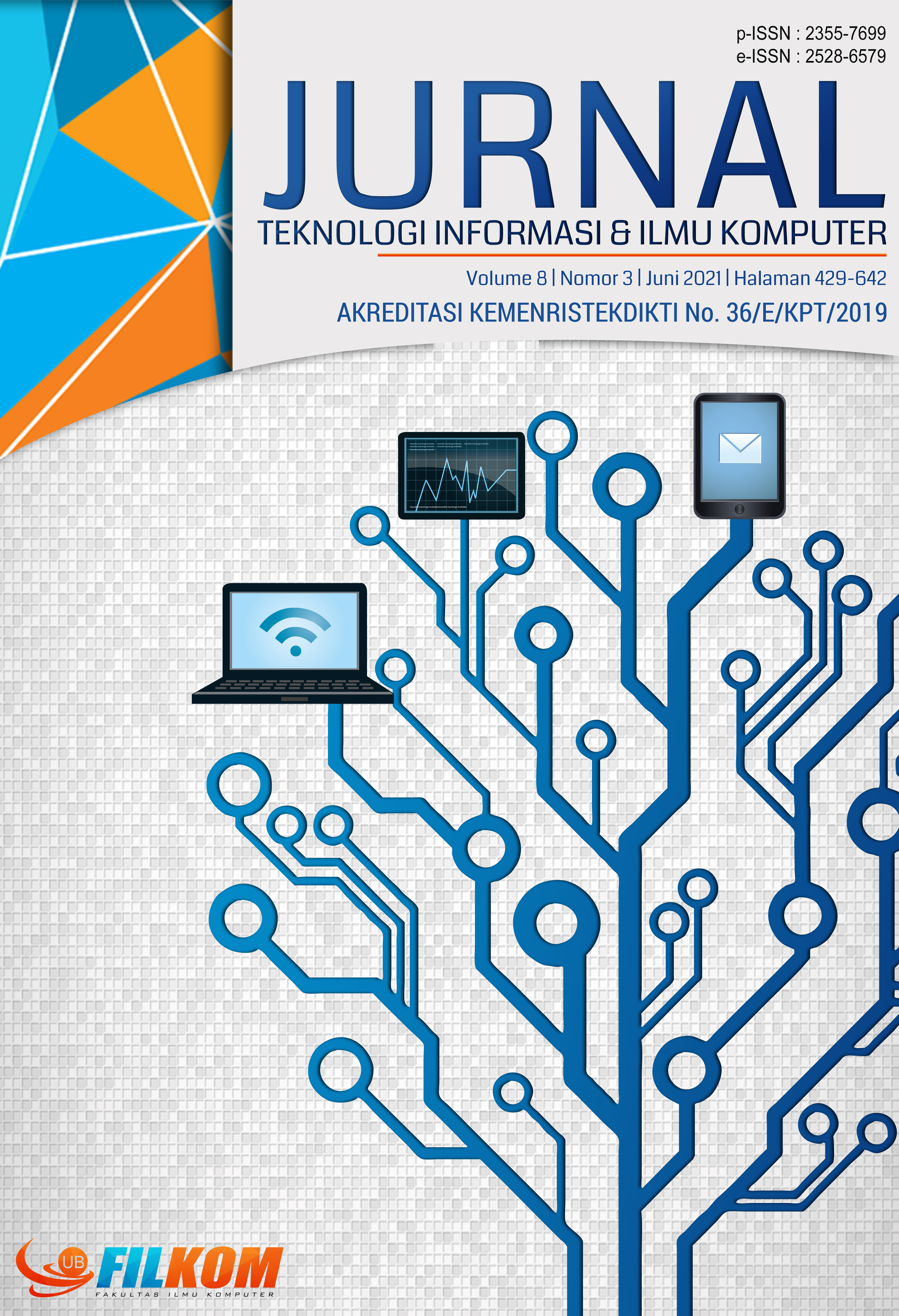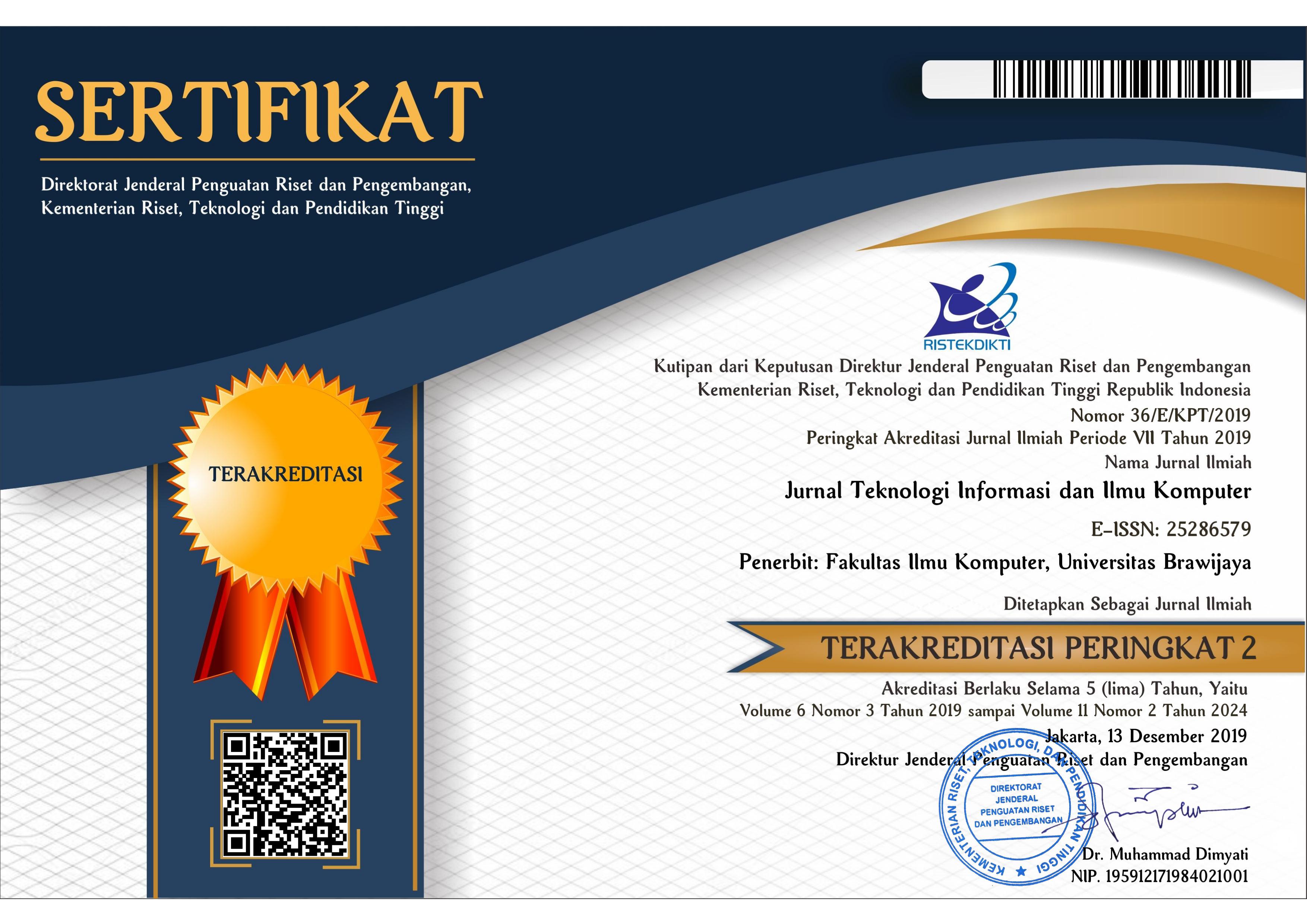Algoritma Deep Learning-LSTM untuk Memprediksi Umur Transformator
DOI:
https://doi.org/10.25126/jtiik.2021834587Abstrak
Kualitas dan ketersediaan pasokan listrik menjadi hal yang sangat penting. Kegagalan pada transformator menyebabkan pemadaman listrik yang dapat menurunkan kualitas layanan kepada pelanggan. Oleh karena itu, pengetahuan tentang umur transformator sangat penting untuk menghindari terjadinya kerusakan transformator secara mendadak yang dapat mengurangi kualitas layanan pada pelanggan. Penelitian ini bertujuan untuk mengembangkan aplikasi yang dapat memprediksi umur transformator secara akurat menggunakan metode Deep Learning-LSTM. LSTM adalah metode yang dapat digunakan untuk mempelajari suatu pola pada data deret waktu. Data yang digunakan dalam penelitian ini bersumber dari 25 unit transformator yang meliputi data dari sensor arus, tegangan, dan suhu. Analisis performa yang digunakan untuk mengukur kinerja LSTM adalah Root Mean Squared Error (RMSE) dan Squared Correlation (SC). Selain LSTM, penelitian ini juga menerapkan algoritma Multilayer Perceptron, Linear Regression, dan Gradient Boosting Regressor sebagai algoritma pembanding. Hasil eksperimen menunjukkan bahwa LSTM mempunyai kinerja yang sangat bagus setelah dilakukan pencarian komposisi data, seleksi fitur menggunakan algoritma KBest dan melakukan percobaan beberapa variasi parameter. Hasil penelitian menunjukkan bahwa metode Deep Learning-LSTM mempunyai kinerja yang lebih baik daripada 3 algoritma lain yaitu nilai RMSE= 0,0004 dan nilai Squared Correlation= 0,9690.
Abstract
The quality and availability of the electricity supply is very important. Failures in the transformer cause power outages which can reduce the quality of service to customers. Therefore, knowledge of transformer life is very important to avoid sudden transformer damage which can reduce the quality of service to customers. This study aims to develop applications that can predict transformer life accurately using the Deep Learning-LSTM method. LSTM is a method that can be used to study a pattern in time series data. The data used in this research comes from 25 transformer units which include data from current, voltage, and temperature sensors. The performance analysis used to measure LSTM performance is Root Mean Squared Error (RMSE) and Squared Correlation (SC). Apart from LSTM, this research also applies the Multilayer Perceptron algorithm, Linear Regression, and Gradient Boosting Regressor as a comparison algorithm. The experimental results show that LSTM has a very good performance after searching for the composition of the data, selecting features using the KBest algorithm and experimenting with several parameter variations. The results showed that the Deep Learning-LSTM method had better performance than the other 3 algorithms, namely the value of RMSE = 0.0004 and the value of Squared Correlation = 0.9690.
Downloads
Referensi
ALQUDSI, A., AND EL-HAG, A. (2019). Application of Machine Learning in Transformer Health Index Prediction. Energies, 12(14), 1–13. https://doi.org/10.3390/en12142694
AZZOUNI, A., AND PUJOLLE, G (2017). NeuTM : A Neural Network-based Framework for Traffic Matrix Prediction in NeuTM : A Neural Network-based Framework for Traffic Matrix Prediction in SDN. October.
BABU, G. S., ZHAO, P., AND LI, X. L. (2016). Deep Convolutional Neural Network Based Regression Approach for Estimation of Remaining Useful Life. Lecture Notes in Computer Science (Including Subseries Lecture Notes in Artificial Intelligence and Lecture Notes in Bioinformatics), 9642, 214–228. https://doi.org/10.1007/978-3-319-32025-0_14
CEFERIN, S., JANC, G., TOROS, Z., KASTELIC, T., AND PRASNIKAR, B. (2017). Power Transformer Monitoring Systems for Better Asset Management. CIRED - Open Access Proceedings Journal, 2017(1), 395–399. https://doi.org/10.1049/oap-cired.2017.1262
DE, A., AND DO, N. (2018). Estimating the Remaining Lifetime of Power Transformers Using Paper Insulation Degradation.
DIWYACITTA, K., PRASOJO, R. A., SUWARNO, S., AND GUMILANG, H. (2017). Effects of Lifetime and Loading Factor on Dissolved Gases in power transformers. ICECOS 2017 - Proceeding of 2017 International Conference on Electrical Engineering and Computer Science: Sustaining the Cultural Heritage Toward the Smart Environment for Better Future, 243–247. https://doi.org/10.1109/ICECOS.2017.8167142
DONG, M., AND GRUMBACH, L. S. (2019). Combining Unsupervised and Supervised Learning for Asset Class Failure Prediction in Power Systems. ArXiv.
GULTOM, P., DANIAL, I, AND RAJAGUKGUK, M. (2017). Studi Susut Umur Transformator Distribusi 20 KV Akibat Pembebanan Lebih. Jurnal Teknik Elektro Universitas Tanjungpura, 2.
ISTIAKE SUNNY, M. A., MASWOOD, M.M.S, AND ALHARBI, A. G. (2020). Deep Learaning-Based Stock Price Prediction Using LSTM and Bi-Directional LSTM Model. NILES 2020, 87–92. https://doi.org/10.1109/NILES50944.2020.9257950
JAHROMI AND PIERCY, R. (2019). An Approach to Power Trabsformer Asset Management. IEEE.
KAVITHA, VARUNA AND RAMYA. (2016). A Comparative Analysis on Linear Regression and Support Vector Regression. IC-GET.
KUMAR, J., GOOMER, R., AND SINGH, A. K. (2018). Long Short Term Memory Recurrent Neural Network (LSTM-RNN) Based Workload Forecasting Model for Cloud Datacenters. Procedia Computer Science, 125, 676–682. https://doi.org/10.1016/j.procs.2017.12.087
LEECUN, Y., BENGIO, Y., AND HINTON, G. (2015). Deep learning. Nature, 521(7553), 436–444. https://doi.org/10.1038/nature14539
MA, M., & MAO, Z. (2019). Deep recurrent convolutional neural network for remaining useful life prediction. 2019 IEEE International Conference on Prognostics and Health Management, ICPHM 2019, 1–4. https://doi.org/10.1109/ICPHM.2019.8819440
MICELI, P. A., BLAIR, W. D., ANF BROWN, M. M. (2018). Deep Learning with Python. In 2018 21st International Conference on Information Fusion, FUSION 2018. https://doi.org/10.23919/ICIF.2018.8455530
Rizki, Y. Y., & Ervianto, E. (2019). Perkiraan umur transformator berdasarkan pengaruh pembebanan dan temperatur lingkungan menggunakan metode trend linear. Jom Fteknik, 6(2), 1–8.
SAKINAH, N., TAHIR, M., BADRIYAH, T., AND SYARIF, I (2019). LSTM with Adam Optimization-Powered High Accuracy Preeclampsia Classification. IES 2019 - International Electronics Symposium: The Role of Techno-Intelligence in Creating an Open Energy System Towards Energy Democracy, Proceedings, 314–319. https://doi.org/10.1109/ELECSYM.2019.8901536
SCHMIDHUBER, S. H. J. (2017). LSTM. Neural Comp, 9(8).
SONG, X., HUANG, J., AND SONG, D. (2019). Air quality prediction based on LSTM-kalman model. Proceedings of 2019 IEEE 8th Joint International Information Technology and Artificial Intelligence Conference, ITAIC 2019, Itaic, 695–699. https://doi.org/10.1109/ITAIC.2019.8785751
TJAHJONO, A., SEPTIAN, W. A., ROSMALIATI, RIKA, N. W., & TAUFIK, T. (2019). Modeling the Temperature of the Distribution Transformer Oil Using Transformer Body Temperature and Power Quality Parameters Based on Artificial Neural Network. 2019 International Conference on Technologies and Policies in Electric Power and Energy, TPEPE 2019, 7–12. https://doi.org/10.1109/IEEECONF48524.2019.9102485
VALTER, P., LINDGREN, P., & PRASAD, R. (2017). Artifcial Intelligence and Deep Lerning in a world of humans and persuasive busines models. IEEE.
Unduhan
Diterbitkan
Terbitan
Bagian
Lisensi

Artikel ini berlisensi Creative Common Attribution-ShareAlike 4.0 International (CC BY-SA 4.0)
Penulis yang menerbitkan di jurnal ini menyetujui ketentuan berikut:
- Penulis menyimpan hak cipta dan memberikan jurnal hak penerbitan pertama naskah secara simultan dengan lisensi di bawah Creative Common Attribution-ShareAlike 4.0 International (CC BY-SA 4.0) yang mengizinkan orang lain untuk berbagi pekerjaan dengan sebuah pernyataan kepenulisan pekerjaan dan penerbitan awal di jurnal ini.
- Penulis bisa memasukkan ke dalam penyusunan kontraktual tambahan terpisah untuk distribusi non ekslusif versi kaya terbitan jurnal (contoh: mempostingnya ke repositori institusional atau menerbitkannya dalam sebuah buku), dengan pengakuan penerbitan awalnya di jurnal ini.
- Penulis diizinkan dan didorong untuk mem-posting karya mereka online (contoh: di repositori institusional atau di website mereka) sebelum dan selama proses penyerahan, karena dapat mengarahkan ke pertukaran produktif, seperti halnya sitiran yang lebih awal dan lebih hebat dari karya yang diterbitkan. (Lihat Efek Akses Terbuka).














